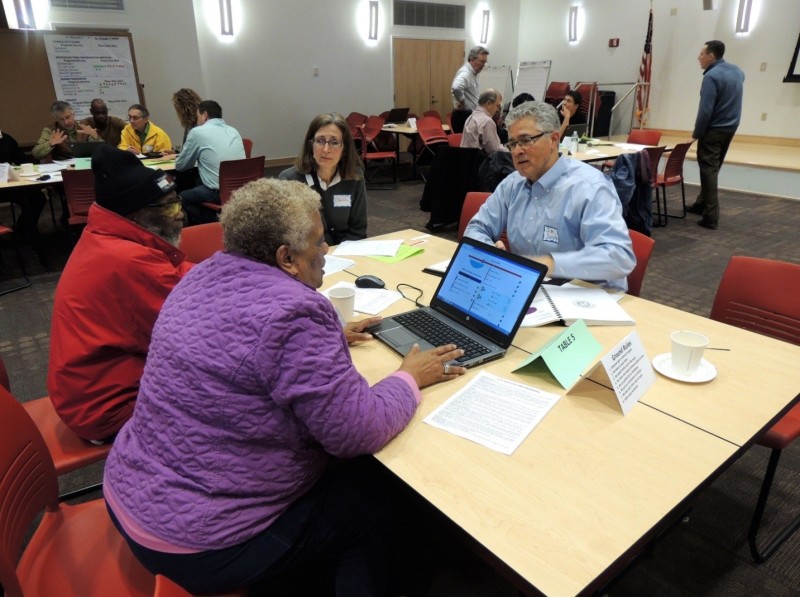

One useful way to look at different methods of civic engagement is the division between “thick” and “thin” efforts. In the words of Matt Leighninger, Vice President of Public Engagement at Public Agenda, thick engagement “[enables] large numbers of people, working in small groups, to learn, decide, and act together,” while thin engagement involves people “as individuals rather than in groups.”
I don’t think it’s as simple as thick always being better than thin. Civic engagement is not a slice of cake. In fact, some of the best projects combine both styles of engagement, as I’ll illustrate below.
Thick vs. Thin
Thick engagements generally incorporate face-to-face meetings where participants share experiences, a number of policy options are presented and discussed, and concrete actions are subsequently planned.
Since 1999, volunteers in the small New Hampshire city have organized dialogues with residents on a number of topics, from debating school redistricting to working on local transportation plans, in coordination with public officials, community groups, and facilitators. Citizens are divided up into small groups which meet to deliberate on the issue at hand, much like a jury, with the results presented to all the stakeholders.
Thin engagements are more diverse and tend to be short-term in nature. Examples range from voting and petition-signing to social media sharing and idea crowdsourcing. Some “thinner” activities are more on the symbolic side, such as placing a bumper sticker on your car or a yard sign on your lawn. Others have tangible impact, like donating money to a project or supporting an online campaign that leads to ample media coverage and changes people’s opinions.
Even though this classification is far from sacrosanct and sometimes unclear (case in point: would a protest be thin? thick? both?), it’s tempting to come to the normative conclusion that thick engagement is superior to thin. But the reality is more complex.
Thin engagement has some clear advantages. It can be completed and iterated far more quickly – in some cases, literally at the click of a mouse. Many online forums provide quick publicity at low marginal cost, when done well. Think of how quickly the Ice Bucket Challenge went viral after people uploaded their own videos. I see similar, though more modest traction with FixMyStreet — a novel municipal service delivery app that generates user recommendations.
Thick engagement, on the other hand, frequently requires more thought and planning. Differentiated from traditional public meetings and hearings with limited opportunities for citizen input (Leighninger labels public hearings as “conventional” engagement), thick activities involve larger-scale public deliberation. They can range from seminal constitution-making processes in nations transitioning to democracy to collaborative planning processes between parents and school administrators. They might include some online activities, such as a neighborhood forum on e-democracy.org, but thick kinds of civic engagement entail a hefty amount of relationship-building before being adopted by a critical mass, and participants engage much more with the online tools (and by extension, their communities) than via thin actions.
The vast majority of findings document the effects of thick engagement. Some snippets: Horizons, a massive five-year public engagement effort dealing with poverty reduction in many communities in the northwest U.S. which involved more than 100,000 people, had impressive results:
- 63% of participating communities report an increase in the number (and diversity) of people who take up community leadership positions,
- 75% subsequently include more people in community decisions, and
- 40% begin to work on systemic poverty reduction efforts afterwards.
In addition, Brazilian participatory budgeting processes have been shown to lead to better managed and more financially sound municipalities as well as improvements in a number of community social indicators linked to income and access to basic services.
Moving Towards a Multifaceted Public Engagement Campaign
None of this is to say, however, that public engagement practitioners have to choose one or the other. In fact, some of the most successful long-term initiatives combine both thick and thin approaches in often surprising ways.
So-called “pothole monitoring” service delivery apps might seem like a thin engagement. Indeed, if users’ actions ceased with each report filed, they would be. But certain players like SeeClickFix have “thickened” it by creating points-based incentives for users to engage others in collectively creating neighborhood “watch areas”.
Moreover, a growing number of thick engagements are incorporating thin elements into their programs.
AmericaSpeaks, an innovative Washington DC nonprofit that recently closed its doors, was at the forefront of this syncretic form of public engagement. It pioneered the incorporation of videoconferencing into multi-site meetings, and later linked online forums with in-person deliberative assemblies.
Much of my work here at Engaged Public is informed by this realization. While we still organize and implement thick, long-term, statewide dialogues involving a multitude of citizens and civic leaders (such as Building a Better Colorado), and while we started offering thin online budget simulation beginning in 2007 with our old Backseat Budgeter application, we do our best to combine thick and thin methods whenever possible.
One of our biggest projects to date, TBD Colorado, epitomized this. Over the course of 70 meetings during a three-month period throughout the Centennial State, we combined aspects of traditional public hearings with facilitated community discussions, included a variety of speakers, complemented it with an interactive website, interspersed it all with keypad polling, and kept people cognizant of the difficult fiscal trade-offs necessary by employing Backseat Budgeter.
I’d love to hear your experiences of civic engagement activities, particularly those that try to bring together thick and thin engagement. Please offer your thoughts or questions in the comment section below!
And check out our original “thick and thin” blog post here.


Hi John,
Thanks for your post. Here’s an overview of how we help city agencies, universities, and civic organizations collaborate with the public – https://medium.com/neighborland/2015-year-in-review-bf4fc1b6e6a3#.dryt1nm19
Let me know if you have any questions,
Dan
Dan Parham – thanks for offering some information about your consulting group, Neighborland. In order to build the conversation, could you please be more specific about your thoughts and approach to “thick” and “thin” participation? Or you could provide a summary of a project and the strengths and challenges you encountered. I think that would help our discussion. Your link shows quite a long document, and you note 200 city agencies and civic organizations in the U.S that have worked with Neighborland. What is important per this line of conversation? Thanks.